40827_fm
Front Matter
Transportation Research Board 2010 Executive Committee
The National Academies - Advisors to the Nation on Science, Engineering, and Medicine
Foreword
Contributors and Acknowledgments
Table of Contents
Volume 1. Concepts
Volume 2. Uninterrupted Flow
Volume 3. Interrupted Flow
Volume 4. Applications Guide
40827_toc
40827_v01_01
40827_v01_02
40827_v01_03
40827_v01_04
40827_v01_05
Front Matter
Table of Contents
Volume 1. Concepts
1. HCM User's Guide
1.1 Introduction
1.2 HCM Purpose and Scope
1.2.1 Purpose and Objectives
1.2.2 Intended Use
1.2.3 Target Users
1.3 Structure
1.3.1 Overview
1.3.2 Volume 1: Concepts
1.3.3 Volume 2: Uninterrupted Flow
1.3.4 Volume 3: Interrupted Flow
1.3.5 Volume 4: Applications Guide
1.3.6 Computational Engines
1.3.7 Commercial Software
1.4 International Use
1.4.1 Applications
1.4.2 Metric Conversion Guide
1.5 What's New in the HCM 2010
1.5.1 Overview
1.5.1.1 Research Basis for the HCM 2010
1.5.1.2 Focus Groups
1.5.1.3 Reorganization from the HCM2000
1.5.1.4 Multimodal Approach
1.5.1.5 Traveler-Perception Models
1.5.1.6 Generalized Service Volume Tables
1.5.2 Methodological Changes by System Element
1.5.2.1 Freeway Facilities
1.5.2.2 Basic Freeway Segments
1.5.2.3 Freeway Weaving Segments
1.5.2.4 Ramps and Ramp Junctions
1.5.2.5 Multilane Highways
1.5.2.6 Two-Lane Highways
1.5.2.7 Urban Street Facilities
1.5.2.7 Urban Street Segments
1.5.2.8 Signalized Intersections
1.5.2.9 Unsignalized Intersections
1.5.2.9.1 Two-Way Stop-Controlled Intersections
1.5.2.9.2 All-Way Stop-Controlled Intersections
1.5.2.9.3 Roundabouts
1.5.2.10 Interchange Ramp Terminals
1.5.2.11 Off-Street Pedestrian and Bicycle Facilities
1.6 Companion Documents
1.6.1 Highway Safety Manual
1.6.2 A Policy on Geometric Design of Highways and Streets
1.6.3 Manual on Uniform Traffic Control Devices
1.6.4 Transit Capacity and Quality of Service Manual
1.7 References
2. Applications
2.1 Introduction
2.2 Levels of Analysis
2.2.1 Overview
2.2.2 Operational Analysis
2.2.3 Design Analysis
2.2.4 Planning and Preliminary Engineering Analysis
2.2.5 Relationship between Analysis Levels and Objectives
2.3 Roadway System Elements
2.3.1 Types of Roadway System Elements
2.3.1.1 Points
2.3.1.2 Segments
2.3.1.3 Facilities
2.3.1.4 Corridors
2.3.1.5 Areas
2.3.1.6 Systems
2.3.2 Analysis of Individual System Elements it is Included to Facilitate
2.3.3 Assessment of Multiple Facilities
2.3.4 System Performance Measurement
2.3.4.1 Quantity of Service
2.3.4.2 Intensity of Congestion
2.3.4.3 Duration of Congestion
2.3.4.4 Extent of Congestion
2.3.4.5 Variability
2.3.4.6 Accessibility
2.4 Travel Modes
2.4.1 Automobile
2.4.2 Pedestrian
2.4.3 Bicycle
2.4.4 Transit
2.5 Operating Conditions
2.5.1 Uninterrupted Flow
2.5.2 Interrupted Flow
2.5.3 Undersaturated Flow
2.5.4 Oversaturated Flow
2.5.5 Queue Discharge Flow
2.6 HCM Analysis as Part of a Broader Process
2.6.1 Noise Analysis
2.6.2 Air Quality Analysis
2.6.3 Economic Analysis
2.6.4 Multimodal Planning Analysis
2.6.5 System Performance Measurement
2.6.6 Summary
2.7 References
3. Modal Characteristics
3.1 Introduction
3.2 Automobile Mode
3.2.1 Vehicle and Human Factors
3.2.1.1 Motor Vehicle Characteristics
3.2.1.2 Driver Characteristics
3.2.2 Variations in Demand
3.2.2.1 Seasonal and Monthly Variations
3.2.2.2 Daily Variations
3.2.2.3 Hourly Variations
3.2.2.4 Peak Hour and Analysis Hour
3.2.2.5 Spatial Distributions
3.2.2.5.1 D-Factor
3.2.3 Travel Time Variability
3.2.4 Automobile Facility Types
3.2.4.1 Uninterrupted Flow
3.2.4.2 Interrupted Flow
3.2.5 Measured and Observed Volumes and Flow Rates
3.2.5.1 Freeways
3.2.5.2 Multilane Highways
3.2.5.3 Rural Two-Way, Two-Lane Highways
3.2.5.4 Urban Streets
3.2.6 Interactions with other Modes
3.2.6.1 Pedestrians
3.2.6.2 Bicycles
3.2.6.3 Transit
3.3 Pedestrian Mode
3.3.1 Overview
3.3.2 Human Factors
3.3.3 Variations in Demand
3.3.4 Pedestrian Facility Types
3.3.4.1 Sidewalks, Walkways, and Pedestrian Zones
3.3.4.2 Queuing Areas
3.3.4.3 Pedestrian Crosswalks
3.3.4.4 Stairways
3.3.4.5 Overpasses and Underpasses
3.3.4.6 Shared Pedestrian-Bicycle Paths
3.3.5 Interactions with other Modes
3.3.5.1 Automobiles
3.3.5.2 Bicycles
3.3.5.3 Transit
3.4 Bicycle Mode
3.4.1 Overview
3.4.2 Human Factors
3.4.3 Variations in Demand
3.4.4 Bicycle Facility Types
3.4.4.1 On-Street Bicycle Facilities
3.4.4.2 Off-Street Bicycle Facilities
3.4.5 Measured and Observed Volumes
3.4.6 Interactions with other Modes
3.4.6.1 Automobiles
3.4.6.2 Pedestrians
3.4.6.3 Transit
3.5 Transit Mode
3.5.1 Overview
3.5.2 Human Factors
3.5.3 On-Street Transit Characteristics
3.5.3.1 Bus
3.5.3.2 Streetcar
3.5.3.3 Light Rail
3.5.4 Travel Time Variability
3.5.5 On-Street Transit Facility Types
3.5.5.1 Mixed Traffic
3.5.5.2 Exclusive Lanes
3.5.5.3 On-Street Transitways
3.5.6 Measured and Observed Volumes
3.5.7 Interactions with other Modes
3.5.7.1 Automobiles
3.5.7.2 Pedestrians
3.5.7.3 Bicycles
3.6 References
4. Traffic Flow and Capacity Concepts
4.1 Introduction
4.2 Automobile Mode
4.2.1 Basic Automobile Flow Parameters
4.2.1.1 Volume and Flow Rate
4.2.1.2 Subhourly Variations in Flow
4.2.1.3 Speed
4.2.1.4 Density
4.2.1.5 Headway and Spacing
4.2.1.6 Relationships among Basic Parameters
4.2.2 Additional Uninterrupted-Flow Parameters
4.2.3 Additional Interrupted-Flow Parameters
4.2.3.1 Signalized Intersection Flow
4.2.3.2 Stop- and Yield-Controlled Intersection Flow
4.2.3.3 Delay
4.2.3.4 Number of Stops
4.2.3.5 Queuing
4.2.4 Capacity Concepts
4.2.4.1 Definition of Capacity
4.2.4.2 Base Conditions
4.2.4.3 Roadway Conditions
4.2.4.4 Traffic Conditions
4.2.4.4.1 Vehicle Type
4.2.4.4.2 Directional and Lane Distribution
4.2.4.4.3 Driver Population
4.2.4.5 Control Conditions
4.2.4.6 Technology
4.2.5 Estimation of Traffic Flow Parameters
4.3 Pedestrian Mode
4.3.1 Pedestrian Characteristics
4.3.1.1 Pedestrian Space Requirements
4.3.1.2 Walking Speed
4.3.1.3 Pedestrian Start-up Time
4.3.2 Pedestrian Flow Parameters
4.3.2.1 Speed, Flow, and Density Relationships
4.3.2.1.1 Speed-Density Relationships
4.3.2.1.2 Flow-Density Relationships
4.3.2.1.3 Speed-Flow Relationships
4.3.2.1.4 Speed-Space Relationships
4.3.2.1.5 Flow on Urban Sidewalks and Walkways
4.3.2.1.6 Pedestrian Type and Trip Purpose
4.3.2.1.7 Influences of Pedestrians on Each other
4.3.2.2 Pedestrian Facility Characteristics
4.3.2.2.1 Untitled
4.3.2.2.2 Pedestrian Platoons
4.3.3 Capacity Concepts
4.3.3.1 Pedestrian Circulation Facilities
4.3.3.2 Pedestrian Queuing Facilities
4.4 Bicycle Mode
4.4.1 Bicycle Flow Parameters
4.4.2 Capacity Concepts
4.4.3 Delay
4.5 Transit Mode
4.5.1 Bus Speed Parameters
4.5.1.1 Operations Characteristics
4.5.1.1.1 Stop Spacing
4.5.1.1.2 Fare Payment
4.5.1.1.3 Service Planning and Scheduling
4.5.1.2 Vehicle Characteristics
4.5.1.3 Roadway Characteristics
4.5.1.3.1 Transit Preferential Treatments
4.5.1.3.2 Bus Stop Location
4.5.1.4 Passenger Characteristics
4.5.1.4.1 Passenger Distribution
4.5.1.4.2 Strollers, Wheelchairs, and Bicycles
4.5.2 Capacity Concepts
4.5.2.1 Differences between Transit and Automobile Capacity
4.5.2.2 Vehicle Capacity
4.5.2.2.1 Loading Area Capacity
4.5.2.2.2 Bus Stop Capacity
4.5.2.2.3 Bus Facility Capacity
4.5.2.3 Person Capacity
4.6 References
5. Quality and Level-of-Service Concepts
5.1 Introduction
5.2 Quality of Service
5.3 Level of Service
5.3.1 Definition
5.3.2 Usage
5.3.2.1 Step Function Nature of LOS
5.3.2.2 Variability of the Inputs to LOS
5.3.2.3 Beyond LOS F
5.3.2.4 Separate LOS Reporting by Mode and System Element
5.3.2.5 LOS as Part of a Bigger Picture
5.4 Service Measures
5.4.1 Definition and Characteristics
5.4.2 Service Measure Selection
5.4.3 Determination of LOS F
5.4.4 Service Measures for Specific System Elements
5.4.4.1 Cross-Cutting Issues
5.4.4.1.1 Automobile Mode
5.4.4.1.2 Pedestrian and Bicycle Modes
5.4.4.1.3 Transit Mode
5.4.4.2 Freeways and Multilane Highways
5.4.4.2.1 Automobile Mode
5.4.4.2.2 Bicycle Mode
5.4.4.3 Two-Lane-Highway Measures
5.4.4.3.1 Automobile Mode
5.4.4.3.2 Bicycle Mode
5.4.4.4 Urban Street Facility and Segment Measures
5.4.4.4.1 Automobile Mode
5.4.4.4.2 Pedestrian Mode
5.4.4.4.3 Bicycle Mode
5.4.4.4.4 Transit Mode
5.4.4.5 Urban Street Intersections
5.4.4.5.1 Automobile Mode
5.4.4.5.2 Pedestrian, Bicycle, and Transit Modes
5.4.4.5.3 Signalized Intersections
5.4.4.5.4 Two-Way Stop-Controlled Intersections
5.4.4.6 Off-Street Pedestrian and Bicycle Facilities
5.4.4.6.1 Pedestrian Mode
5.4.4.6.2 Bicycle Mode
5.5 References
6. HCM and Alternative Analysis Tools
6.1 Introduction
6.2 HCM-Based Tools
6.2.1 Generalized Service Volume Tables
6.2.2 Application of Default Values to HCM Methodologies
6.2.3 Operations-Level HCM Analysis
6.3 Alternative Tools
6.3.1 Overview
6.3.2 Traffic Modeling Concepts and Terminology
6.3.2.1 Hierarchy of Modeling Terminology
6.3.2.2 Additional Modeling Definitions
6.3.2.3 Traffic Analysis Tool and Model Categories
6.3.2.4 Stochastic and Deterministic Models
6.3.2.5 Static Flow and Time-Varying Flow Models
6.3.2.6 Descriptive and Normative Models
6.3.3 Conceptual Differences between Deterministic and Simulation Tools
6.3.4 Appropriate Use of Alternative Tools
6.3.5 Application Framework for Alternative Tools
6.3.5.1 Freeways
6.3.5.2 Urban Streets
6.3.5.3 Two-Lane and Multilane Highways
6.3.5.4 Corridor and Areawide Analysis
6.3.6 Performance Measures from Alternative Tools
6.3.7 Traffic Analysis Tool Selection Criteria
6.3.7.1 Determining Project Scope
6.3.7.2 Assessing HCM Methodologies
6.3.7.3 Selecting a Traffic Analysis Tool
6.3.7.3.1 Model Development Environment and Process
6.3.7.3.2 Model Capabilities
6.3.7.3.3 Data Availability
6.3.7.3.4 Data for Model Input
6.3.7.3.5 Data for Model Calibration
6.3.7.3.6 Data Sources
6.3.7.3.7 Ease of Use
6.3.7.3.8 Required Resources
6.3.7.3.9 User Applications and Past Performance
6.3.7.3.10 Verification and Validation
6.3.8 Application Guidelines for Simulation Tools
6.3.8.1 Assembling Data
6.3.8.2 Entering Data
6.3.8.3 Calibrating and Validating Models
6.3.8.4 Special Considerations for DTA
6.3.8.5 Analyzing Output
6.3.8.6 Analyzing Alternatives
6.4 References
Appendix A: Developing Local Default Values
Appendix B: Developing Local Service Volume Tables
7. Interpreting HCM and Alternative Tool Results
7.1 Introduction
7.2 Uncertainty and Variability
7.2.1 Uncertainty and Variability Concepts
7.2.2 Sources of Uncertainty
7.2.2.1 Input Variables
7.2.2.2 Model Accuracy
7.2.2.2.1 Model Development
7.2.2.2.2 Nested Algorithms
7.2.2.2.3 Traveler Perception
7.2.2.2.4 Additional Documentation
7.2.2.3 Model Specification
7.2.3 Sensitivity Analysis
7.2.4 Accuracy and Precision
7.2.4.1 Overview
7.2.4.2 Calculation Precision versus Display Precision
7.2.4.3 Implied Precision of Results
7.2.5 Average Values
7.3 Defining and Computing Uniform Performance Measures
7.3.1 Performance Measures Reported by HCM Procedures
7.3.1.1 Speed-Related Measures
7.3.1.2 Queue-Related Measures
7.3.1.3 Stop-Related Measures among Tools
7.3.1.4 Delay-Related Measures
7.3.1.5 Density-Related Measures
7.3.2 Use of Vehicle Trajectory Analysis in Comparing Performance Measures
7.3.2.1 Mathematical Properties of Vehicle Trajectory
7.3.2.2 Longitudinal and Spatial Analysis
7.3.2.3 Limitations of Vehicle Trajectory Analysis
7.3.2.3.1 Traffic Modeling Differences
7.3.2.3.2 Approximations in Trajectory Analysis
7.3.2.3.3 Differences That are Unrelated to Trajectory Analysis
7.3.2.4 Examples of Vehicle Trajectory Data
7.3.3 Requirements for Computing Performance Measures by Vehicle Trajectory Analysis
7.3.3.1 General Trajectory Analysis Guidelines
7.3.3.2 Speed- and Travel Time-Related Measures
7.3.3.3 Queue-Related Measures
7.3.3.3.1 Queued State
7.3.3.3.2 Queue Length
7.3.3.4 Stop-Related Measures
7.3.3.4.1 Definition of the Stopped State
7.3.3.4.2 Estimating the Number of Stops
7.3.3.5 Delay-Related Measures
7.3.3.5.1 Delay Definitions
7.3.3.5.2 Aggregated Delay versus Unit Delay
7.3.3.5.3 Representation of Delay by Vehicle Trajectories
7.3.3.5.4 Computational Procedures for Delay-Related Measures
7.3.3.5.5 Special Delay Estimation Issues
7.3.3.6 Density-Related Measures
7.3.3.6.1 Computational Procedures
7.3.3.6.2 Follower Density
7.3.4 Stochastic Aspects of Simulation Analysis
7.3.4.1 Number of Required Repetitions
7.3.4.2 Expected Variation between Runs
7.3.5 Comparing HCM Analysis Results with Alternative Tools
7.3.5.1 Conceptual Differences between Modeling Approaches
7.3.5.2 Framework for Comparison of Performance Measures
7.3.5.3 LOS Comparisons
7.3.5.4 Estimation of Capacity by Simulation
7.3.5.5 Temporal and Spatial Boundaries
7.3.5.5.1 Complete versus Incomplete Trips
7.3.5.5.2 Delay on Oversaturated Signalized Approaches
7.3.5.5.3 Delay for Multiperiod Oversaturation
7.4 Presentation of Results
7.4.1 Guidance on the Display of HCM Results
7.4.1.1 Input Values
7.4.1.2 Adjustment Factors
7.4.1.3 Service Volume Tables
7.4.1.4 Free-Flow Speed
7.4.1.5 Speeds
7.4.1.6 Volume-to-Capacity and Demand-to-Capacity Ratios
7.4.1.7 Delay
7.4.1.8 Density
7.4.1.9 Pedestrian Space
7.4.1.10 Occurrences and Events
7.4.1.11 General Factors
7.4.2 Presenting Results to Facilitate Interpretation
7.4.3 Graphic Representation of Results
7.5 References
8. HCM Primer
8.1 Introduction
8.2 Highway Capacity Concepts
8.2.1 Definition of Capacity
8.2.2 Uninterrupted-Flow Roadways
8.2.2.1 Characteristics
8.2.2.2 HCM Methodologies
8.2.2.3 Performance Measures
8.2.3 Interrupted-Flow Roadways
8.2.3.1 Characteristics
8.2.3.2 HCM Methodologies
8.2.3.3 Performance Measures
8.2.4 Modal Interactions
8.3 Quality and Level-of-Service Concepts
8.3.1 Overview
8.3.2 Quality of Service
8.3.3 Level of Service
8.3.3.1 Step Function Nature of LOS
8.3.3.2 Uncertainty and False Precision
8.3.3.3 LOS Reported Separately by Mode
8.3.3.4 Reporting the Big Picture
8.3.4 Service Measures
8.4 Analysis Process
8.4.1 Levels of HCM Analysis
8.4.1.1 Operational Analysis
8.4.1.2 Planning and Preliminary Engineering Analysis
8.4.1.3 Generalized Service-Volume Tables
8.4.1.4 Design Analysis
8.4.2 Analysis Tool Selection
8.4.2.1 Types of Tools
8.4.2.2 Situations When Alternative Tools Might Be Considered
8.4.3 Interpreting Results
8.4.3.1 Uncertainty and Variability
8.4.3.2 Accuracy and Precision
8.4.3.3 Comparing HCM Results with Alternative Tools
8.4.3.3.1 Use of Vehicle Trajectory Analysis in Determining Performance Measures
8.4.3.3.2 Temporal and Spatial Boundaries
8.4.4 Presenting Results
8.5 Decision-Making Considerations
8.5.1 Role of HCM Companion Documents
8.5.1.1 Highway Safety Manual
8.5.1.2 A Policy on Geometric Design of Highways and Streets
8.5.1.3 Manual on Uniform Traffic Control Devices
8.5.1.4 Transit Capacity and Quality of Service Manual
8.5.2 Tools versus Standards
8.5.2.1 Evolution of HCM Analysis Procedures
8.5.2.2 Incorporating HCM Analysis Results into Decision Making
8.5.2.2.1 Traffic Signal Warrants
8.5.2.2.2 Turn-Lane Warrants
8.6 References
9. Glossary and Symbols
9.1 Glossary
9.2 List of Symbols
Volume 1 Index
Volume 2. Uninterrupted Flow
Volume 3. Interrupted Flow
Volume 4. Applications Guide
40827_v01_06
40827_v01_07
Front Matter
Table of Contents
Volume 1. Concepts
1. HCM User's Guide
1.1 Introduction
1.2 HCM Purpose and Scope
1.2.1 Purpose and Objectives
1.2.2 Intended Use
1.2.3 Target Users
1.3 Structure
1.3.1 Overview
1.3.2 Volume 1: Concepts
1.3.3 Volume 2: Uninterrupted Flow
1.3.4 Volume 3: Interrupted Flow
1.3.5 Volume 4: Applications Guide
1.3.6 Computational Engines
1.3.7 Commercial Software
1.4 International Use
1.4.1 Applications
1.4.2 Metric Conversion Guide
1.5 What's New in the HCM 2010
1.5.1 Overview
1.5.1.1 Research Basis for the HCM 2010
1.5.1.2 Focus Groups
1.5.1.3 Reorganization from the HCM2000
1.5.1.4 Multimodal Approach
1.5.1.5 Traveler-Perception Models
1.5.1.6 Generalized Service Volume Tables
1.5.2 Methodological Changes by System Element
1.5.2.1 Freeway Facilities
1.5.2.2 Basic Freeway Segments
1.5.2.3 Freeway Weaving Segments
1.5.2.4 Ramps and Ramp Junctions
1.5.2.5 Multilane Highways
1.5.2.6 Two-Lane Highways
1.5.2.7 Urban Street Facilities
1.5.2.7 Urban Street Segments
1.5.2.8 Signalized Intersections
1.5.2.9 Unsignalized Intersections
1.5.2.9.1 Two-Way Stop-Controlled Intersections
1.5.2.9.2 All-Way Stop-Controlled Intersections
1.5.2.9.3 Roundabouts
1.5.2.10 Interchange Ramp Terminals
1.5.2.11 Off-Street Pedestrian and Bicycle Facilities
1.6 Companion Documents
1.6.1 Highway Safety Manual
1.6.2 A Policy on Geometric Design of Highways and Streets
1.6.3 Manual on Uniform Traffic Control Devices
1.6.4 Transit Capacity and Quality of Service Manual
1.7 References
2. Applications
2.1 Introduction
2.2 Levels of Analysis
2.2.1 Overview
2.2.2 Operational Analysis
2.2.3 Design Analysis
2.2.4 Planning and Preliminary Engineering Analysis
2.2.5 Relationship between Analysis Levels and Objectives
2.3 Roadway System Elements
2.3.1 Types of Roadway System Elements
2.3.1.1 Points
2.3.1.2 Segments
2.3.1.3 Facilities
2.3.1.4 Corridors
2.3.1.5 Areas
2.3.1.6 Systems
2.3.2 Analysis of Individual System Elements it is Included to Facilitate
2.3.3 Assessment of Multiple Facilities
2.3.4 System Performance Measurement
2.3.4.1 Quantity of Service
2.3.4.2 Intensity of Congestion
2.3.4.3 Duration of Congestion
2.3.4.4 Extent of Congestion
2.3.4.5 Variability
2.3.4.6 Accessibility
2.4 Travel Modes
2.4.1 Automobile
2.4.2 Pedestrian
2.4.3 Bicycle
2.4.4 Transit
2.5 Operating Conditions
2.5.1 Uninterrupted Flow
2.5.2 Interrupted Flow
2.5.3 Undersaturated Flow
2.5.4 Oversaturated Flow
2.5.5 Queue Discharge Flow
2.6 HCM Analysis as Part of a Broader Process
2.6.1 Noise Analysis
2.6.2 Air Quality Analysis
2.6.3 Economic Analysis
2.6.4 Multimodal Planning Analysis
2.6.5 System Performance Measurement
2.6.6 Summary
2.7 References
3. Modal Characteristics
3.1 Introduction
3.2 Automobile Mode
3.2.1 Vehicle and Human Factors
3.2.1.1 Motor Vehicle Characteristics
3.2.1.2 Driver Characteristics
3.2.2 Variations in Demand
3.2.2.1 Seasonal and Monthly Variations
3.2.2.2 Daily Variations
3.2.2.3 Hourly Variations
3.2.2.4 Peak Hour and Analysis Hour
3.2.2.5 Spatial Distributions
3.2.2.5.1 D-Factor
3.2.3 Travel Time Variability
3.2.4 Automobile Facility Types
3.2.4.1 Uninterrupted Flow
3.2.4.2 Interrupted Flow
3.2.5 Measured and Observed Volumes and Flow Rates
3.2.5.1 Freeways
3.2.5.2 Multilane Highways
3.2.5.3 Rural Two-Way, Two-Lane Highways
3.2.5.4 Urban Streets
3.2.6 Interactions with other Modes
3.2.6.1 Pedestrians
3.2.6.2 Bicycles
3.2.6.3 Transit
3.3 Pedestrian Mode
3.3.1 Overview
3.3.2 Human Factors
3.3.3 Variations in Demand
3.3.4 Pedestrian Facility Types
3.3.4.1 Sidewalks, Walkways, and Pedestrian Zones
3.3.4.2 Queuing Areas
3.3.4.3 Pedestrian Crosswalks
3.3.4.4 Stairways
3.3.4.5 Overpasses and Underpasses
3.3.4.6 Shared Pedestrian-Bicycle Paths
3.3.5 Interactions with other Modes
3.3.5.1 Automobiles
3.3.5.2 Bicycles
3.3.5.3 Transit
3.4 Bicycle Mode
3.4.1 Overview
3.4.2 Human Factors
3.4.3 Variations in Demand
3.4.4 Bicycle Facility Types
3.4.4.1 On-Street Bicycle Facilities
3.4.4.2 Off-Street Bicycle Facilities
3.4.5 Measured and Observed Volumes
3.4.6 Interactions with other Modes
3.4.6.1 Automobiles
3.4.6.2 Pedestrians
3.4.6.3 Transit
3.5 Transit Mode
3.5.1 Overview
3.5.2 Human Factors
3.5.3 On-Street Transit Characteristics
3.5.3.1 Bus
3.5.3.2 Streetcar
3.5.3.3 Light Rail
3.5.4 Travel Time Variability
3.5.5 On-Street Transit Facility Types
3.5.5.1 Mixed Traffic
3.5.5.2 Exclusive Lanes
3.5.5.3 On-Street Transitways
3.5.6 Measured and Observed Volumes
3.5.7 Interactions with other Modes
3.5.7.1 Automobiles
3.5.7.2 Pedestrians
3.5.7.3 Bicycles
3.6 References
4. Traffic Flow and Capacity Concepts
4.1 Introduction
4.2 Automobile Mode
4.2.1 Basic Automobile Flow Parameters
4.2.1.1 Volume and Flow Rate
4.2.1.2 Subhourly Variations in Flow
4.2.1.3 Speed
4.2.1.4 Density
4.2.1.5 Headway and Spacing
4.2.1.6 Relationships among Basic Parameters
4.2.2 Additional Uninterrupted-Flow Parameters
4.2.3 Additional Interrupted-Flow Parameters
4.2.3.1 Signalized Intersection Flow
4.2.3.2 Stop- and Yield-Controlled Intersection Flow
4.2.3.3 Delay
4.2.3.4 Number of Stops
4.2.3.5 Queuing
4.2.4 Capacity Concepts
4.2.4.1 Definition of Capacity
4.2.4.2 Base Conditions
4.2.4.3 Roadway Conditions
4.2.4.4 Traffic Conditions
4.2.4.4.1 Vehicle Type
4.2.4.4.2 Directional and Lane Distribution
4.2.4.4.3 Driver Population
4.2.4.5 Control Conditions
4.2.4.6 Technology
4.2.5 Estimation of Traffic Flow Parameters
4.3 Pedestrian Mode
4.3.1 Pedestrian Characteristics
4.3.1.1 Pedestrian Space Requirements
4.3.1.2 Walking Speed
4.3.1.3 Pedestrian Start-up Time
4.3.2 Pedestrian Flow Parameters
4.3.2.1 Speed, Flow, and Density Relationships
4.3.2.1.1 Speed-Density Relationships
4.3.2.1.2 Flow-Density Relationships
4.3.2.1.3 Speed-Flow Relationships
4.3.2.1.4 Speed-Space Relationships
4.3.2.1.5 Flow on Urban Sidewalks and Walkways
4.3.2.1.6 Pedestrian Type and Trip Purpose
4.3.2.1.7 Influences of Pedestrians on Each other
4.3.2.2 Pedestrian Facility Characteristics
4.3.2.2.1 Untitled
4.3.2.2.2 Pedestrian Platoons
4.3.3 Capacity Concepts
4.3.3.1 Pedestrian Circulation Facilities
4.3.3.2 Pedestrian Queuing Facilities
4.4 Bicycle Mode
4.4.1 Bicycle Flow Parameters
4.4.2 Capacity Concepts
4.4.3 Delay
4.5 Transit Mode
4.5.1 Bus Speed Parameters
4.5.1.1 Operations Characteristics
4.5.1.1.1 Stop Spacing
4.5.1.1.2 Fare Payment
4.5.1.1.3 Service Planning and Scheduling
4.5.1.2 Vehicle Characteristics
4.5.1.3 Roadway Characteristics
4.5.1.3.1 Transit Preferential Treatments
4.5.1.3.2 Bus Stop Location
4.5.1.4 Passenger Characteristics
4.5.1.4.1 Passenger Distribution
4.5.1.4.2 Strollers, Wheelchairs, and Bicycles
4.5.2 Capacity Concepts
4.5.2.1 Differences between Transit and Automobile Capacity
4.5.2.2 Vehicle Capacity
4.5.2.2.1 Loading Area Capacity
4.5.2.2.2 Bus Stop Capacity
4.5.2.2.3 Bus Facility Capacity
4.5.2.3 Person Capacity
4.6 References
5. Quality and Level-of-Service Concepts
5.1 Introduction
5.2 Quality of Service
5.3 Level of Service
5.3.1 Definition
5.3.2 Usage
5.3.2.1 Step Function Nature of LOS
5.3.2.2 Variability of the Inputs to LOS
5.3.2.3 Beyond LOS F
5.3.2.4 Separate LOS Reporting by Mode and System Element
5.3.2.5 LOS as Part of a Bigger Picture
5.4 Service Measures
5.4.1 Definition and Characteristics
5.4.2 Service Measure Selection
5.4.3 Determination of LOS F
5.4.4 Service Measures for Specific System Elements
5.4.4.1 Cross-Cutting Issues
5.4.4.1.1 Automobile Mode
5.4.4.1.2 Pedestrian and Bicycle Modes
5.4.4.1.3 Transit Mode
5.4.4.2 Freeways and Multilane Highways
5.4.4.2.1 Automobile Mode
5.4.4.2.2 Bicycle Mode
5.4.4.3 Two-Lane-Highway Measures
5.4.4.3.1 Automobile Mode
5.4.4.3.2 Bicycle Mode
5.4.4.4 Urban Street Facility and Segment Measures
5.4.4.4.1 Automobile Mode
5.4.4.4.2 Pedestrian Mode
5.4.4.4.3 Bicycle Mode
5.4.4.4.4 Transit Mode
5.4.4.5 Urban Street Intersections
5.4.4.5.1 Automobile Mode
5.4.4.5.2 Pedestrian, Bicycle, and Transit Modes
5.4.4.5.3 Signalized Intersections
5.4.4.5.4 Two-Way Stop-Controlled Intersections
5.4.4.6 Off-Street Pedestrian and Bicycle Facilities
5.4.4.6.1 Pedestrian Mode
5.4.4.6.2 Bicycle Mode
5.5 References
6. HCM and Alternative Analysis Tools
6.1 Introduction
6.2 HCM-Based Tools
6.2.1 Generalized Service Volume Tables
6.2.2 Application of Default Values to HCM Methodologies
6.2.3 Operations-Level HCM Analysis
6.3 Alternative Tools
6.3.1 Overview
6.3.2 Traffic Modeling Concepts and Terminology
6.3.2.1 Hierarchy of Modeling Terminology
6.3.2.2 Additional Modeling Definitions
6.3.2.3 Traffic Analysis Tool and Model Categories
6.3.2.4 Stochastic and Deterministic Models
6.3.2.5 Static Flow and Time-Varying Flow Models
6.3.2.6 Descriptive and Normative Models
6.3.3 Conceptual Differences between Deterministic and Simulation Tools
6.3.4 Appropriate Use of Alternative Tools
6.3.5 Application Framework for Alternative Tools
6.3.5.1 Freeways
6.3.5.2 Urban Streets
6.3.5.3 Two-Lane and Multilane Highways
6.3.5.4 Corridor and Areawide Analysis
6.3.6 Performance Measures from Alternative Tools
6.3.7 Traffic Analysis Tool Selection Criteria
6.3.7.1 Determining Project Scope
6.3.7.2 Assessing HCM Methodologies
6.3.7.3 Selecting a Traffic Analysis Tool
6.3.7.3.1 Model Development Environment and Process
6.3.7.3.2 Model Capabilities
6.3.7.3.3 Data Availability
6.3.7.3.4 Data for Model Input
6.3.7.3.5 Data for Model Calibration
6.3.7.3.6 Data Sources
6.3.7.3.7 Ease of Use
6.3.7.3.8 Required Resources
6.3.7.3.9 User Applications and Past Performance
6.3.7.3.10 Verification and Validation
6.3.8 Application Guidelines for Simulation Tools
6.3.8.1 Assembling Data
6.3.8.2 Entering Data
6.3.8.3 Calibrating and Validating Models
6.3.8.4 Special Considerations for DTA
6.3.8.5 Analyzing Output
6.3.8.6 Analyzing Alternatives
6.4 References
Appendix A: Developing Local Default Values
Appendix B: Developing Local Service Volume Tables
7. Interpreting HCM and Alternative Tool Results
7.1 Introduction
7.2 Uncertainty and Variability
7.2.1 Uncertainty and Variability Concepts
7.2.2 Sources of Uncertainty
7.2.2.1 Input Variables
7.2.2.2 Model Accuracy
7.2.2.2.1 Model Development
7.2.2.2.2 Nested Algorithms
7.2.2.2.3 Traveler Perception
7.2.2.2.4 Additional Documentation
7.2.2.3 Model Specification
7.2.3 Sensitivity Analysis
7.2.4 Accuracy and Precision
7.2.4.1 Overview
7.2.4.2 Calculation Precision versus Display Precision
7.2.4.3 Implied Precision of Results
7.2.5 Average Values
7.3 Defining and Computing Uniform Performance Measures
7.3.1 Performance Measures Reported by HCM Procedures
7.3.1.1 Speed-Related Measures
7.3.1.2 Queue-Related Measures
7.3.1.3 Stop-Related Measures among Tools
7.3.1.4 Delay-Related Measures
7.3.1.5 Density-Related Measures
7.3.2 Use of Vehicle Trajectory Analysis in Comparing Performance Measures
7.3.2.1 Mathematical Properties of Vehicle Trajectory
7.3.2.2 Longitudinal and Spatial Analysis
7.3.2.3 Limitations of Vehicle Trajectory Analysis
7.3.2.3.1 Traffic Modeling Differences
7.3.2.3.2 Approximations in Trajectory Analysis
7.3.2.3.3 Differences That are Unrelated to Trajectory Analysis
7.3.2.4 Examples of Vehicle Trajectory Data
7.3.3 Requirements for Computing Performance Measures by Vehicle Trajectory Analysis
7.3.3.1 General Trajectory Analysis Guidelines
7.3.3.2 Speed- and Travel Time-Related Measures
7.3.3.3 Queue-Related Measures
7.3.3.3.1 Queued State
7.3.3.3.2 Queue Length
7.3.3.4 Stop-Related Measures
7.3.3.4.1 Definition of the Stopped State
7.3.3.4.2 Estimating the Number of Stops
7.3.3.5 Delay-Related Measures
7.3.3.5.1 Delay Definitions
7.3.3.5.2 Aggregated Delay versus Unit Delay
7.3.3.5.3 Representation of Delay by Vehicle Trajectories
7.3.3.5.4 Computational Procedures for Delay-Related Measures
7.3.3.5.5 Special Delay Estimation Issues
7.3.3.6 Density-Related Measures
7.3.3.6.1 Computational Procedures
7.3.3.6.2 Follower Density
7.3.4 Stochastic Aspects of Simulation Analysis
7.3.4.1 Number of Required Repetitions
7.3.4.2 Expected Variation between Runs
7.3.5 Comparing HCM Analysis Results with Alternative Tools
7.3.5.1 Conceptual Differences between Modeling Approaches
7.3.5.2 Framework for Comparison of Performance Measures
7.3.5.3 LOS Comparisons
7.3.5.4 Estimation of Capacity by Simulation
7.3.5.5 Temporal and Spatial Boundaries
7.3.5.5.1 Complete versus Incomplete Trips
7.3.5.5.2 Delay on Oversaturated Signalized Approaches
7.3.5.5.3 Delay for Multiperiod Oversaturation
7.4 Presentation of Results
7.4.1 Guidance on the Display of HCM Results
7.4.1.1 Input Values
7.4.1.2 Adjustment Factors
7.4.1.3 Service Volume Tables
7.4.1.4 Free-Flow Speed
7.4.1.5 Speeds
7.4.1.6 Volume-to-Capacity and Demand-to-Capacity Ratios
7.4.1.7 Delay
7.4.1.8 Density
7.4.1.9 Pedestrian Space
7.4.1.10 Occurrences and Events
7.4.1.11 General Factors
7.4.2 Presenting Results to Facilitate Interpretation
7.4.3 Graphic Representation of Results
7.5 References
8. HCM Primer
8.1 Introduction
8.2 Highway Capacity Concepts
8.2.1 Definition of Capacity
8.2.2 Uninterrupted-Flow Roadways
8.2.2.1 Characteristics
8.2.2.2 HCM Methodologies
8.2.2.3 Performance Measures
8.2.3 Interrupted-Flow Roadways
8.2.3.1 Characteristics
8.2.3.2 HCM Methodologies
8.2.3.3 Performance Measures
8.2.4 Modal Interactions
8.3 Quality and Level-of-Service Concepts
8.3.1 Overview
8.3.2 Quality of Service
8.3.3 Level of Service
8.3.3.1 Step Function Nature of LOS
8.3.3.2 Uncertainty and False Precision
8.3.3.3 LOS Reported Separately by Mode
8.3.3.4 Reporting the Big Picture
8.3.4 Service Measures
8.4 Analysis Process
8.4.1 Levels of HCM Analysis
8.4.1.1 Operational Analysis
8.4.1.2 Planning and Preliminary Engineering Analysis
8.4.1.3 Generalized Service-Volume Tables
8.4.1.4 Design Analysis
8.4.2 Analysis Tool Selection
8.4.2.1 Types of Tools
8.4.2.2 Situations When Alternative Tools Might Be Considered
8.4.3 Interpreting Results
8.4.3.1 Uncertainty and Variability
8.4.3.2 Accuracy and Precision
8.4.3.3 Comparing HCM Results with Alternative Tools
8.4.3.3.1 Use of Vehicle Trajectory Analysis in Determining Performance Measures
8.4.3.3.2 Temporal and Spatial Boundaries
8.4.4 Presenting Results
8.5 Decision-Making Considerations
8.5.1 Role of HCM Companion Documents
8.5.1.1 Highway Safety Manual
8.5.1.2 A Policy on Geometric Design of Highways and Streets
8.5.1.3 Manual on Uniform Traffic Control Devices
8.5.1.4 Transit Capacity and Quality of Service Manual
8.5.2 Tools versus Standards
8.5.2.1 Evolution of HCM Analysis Procedures
8.5.2.2 Incorporating HCM Analysis Results into Decision Making
8.5.2.2.1 Traffic Signal Warrants
8.5.2.2.2 Turn-Lane Warrants
8.6 References
9. Glossary and Symbols
9.1 Glossary
9.2 List of Symbols
Volume 1 Index
Volume 2. Uninterrupted Flow
Volume 3. Interrupted Flow
Volume 4. Applications Guide
40827_v01_08
40827_v01_09
40827_v01_indx
40827_v02_10
40827_v02_11
40827_v02_12
40827_v02_13
40827_v02_14
40827_v02_15
40827_v02_indx
40827_v03_16
40827_v03_17
40827_v03_18
40827_v03_19
40827_v03_20
40827_v03_21
40827_v03_22
40827_v03_23
40827_v03_indx
40827_v04_24
40827_v04_25
40827_v04_26
40827_v04_27
40827_v04_28
40827_v04_29
40827_v04_30
40827_v04_31
40827_v04_32
40827_v04_33
40827_v04_34
40827_v04_35
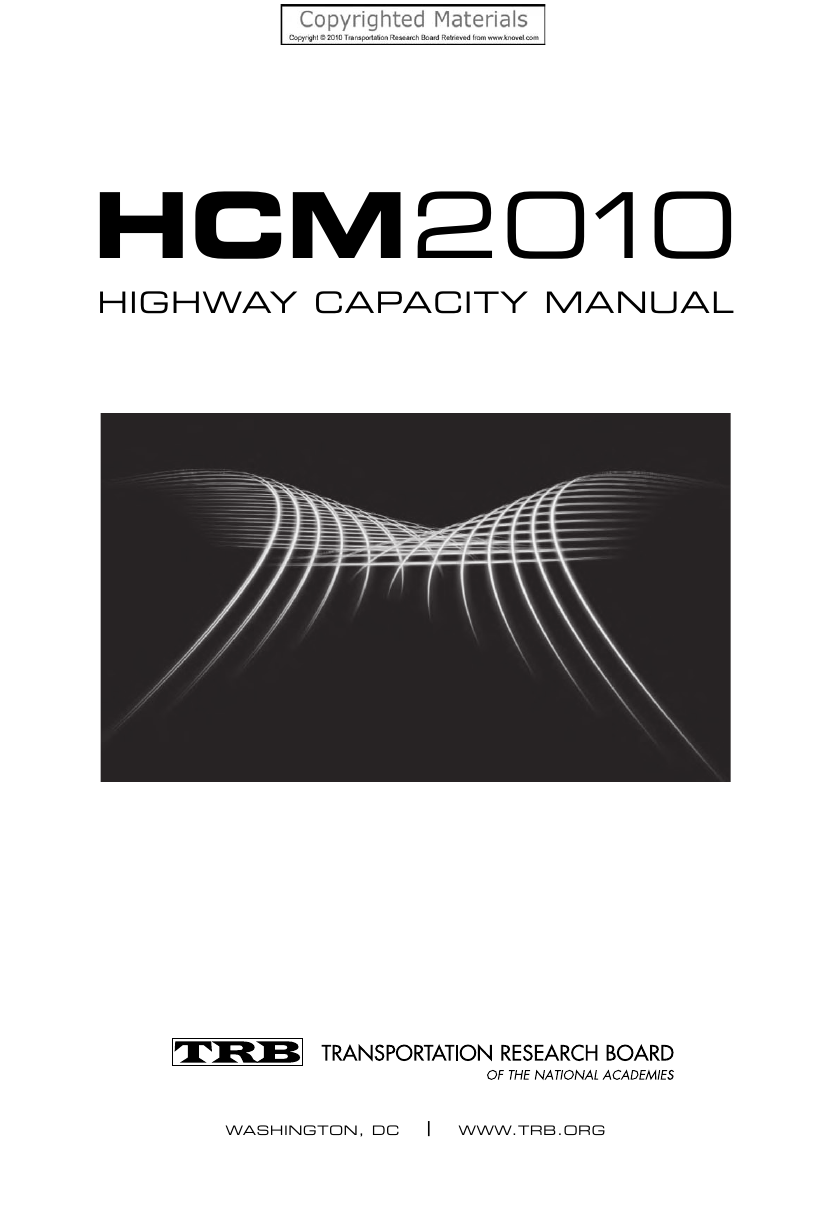
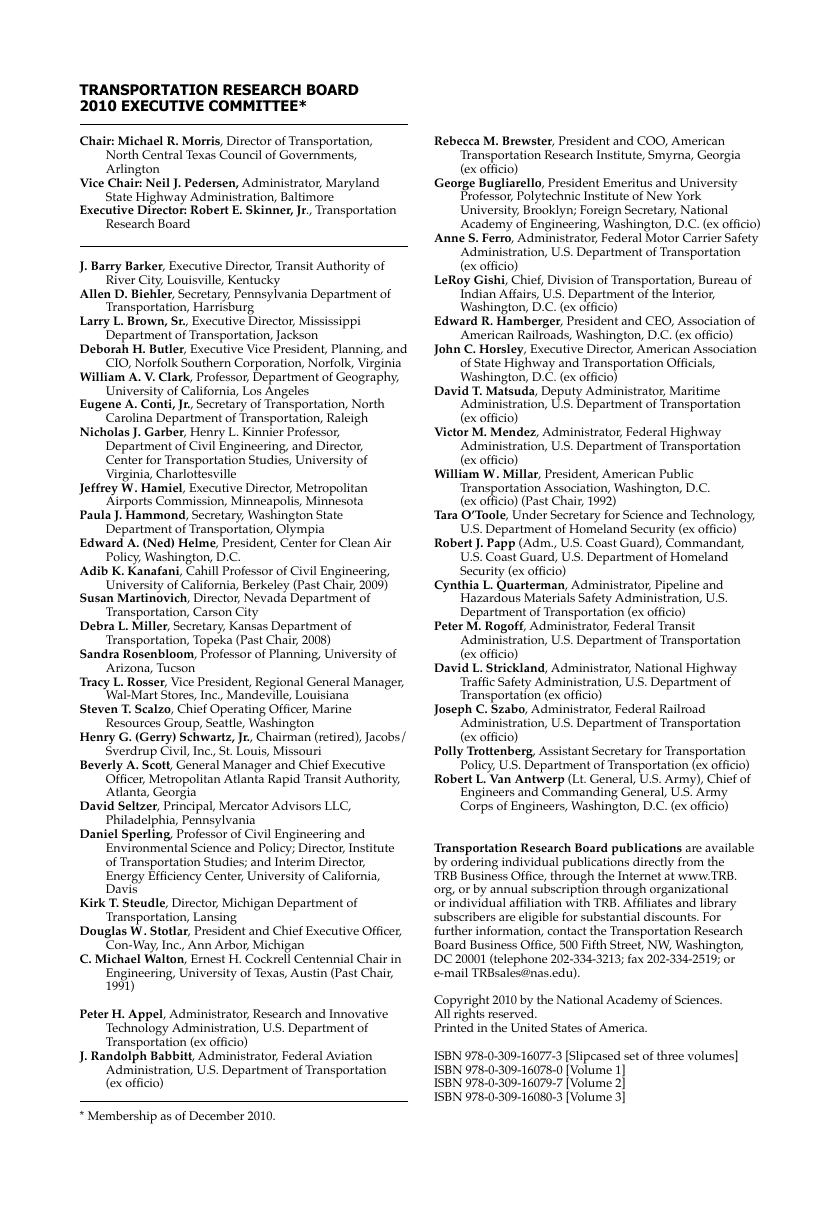
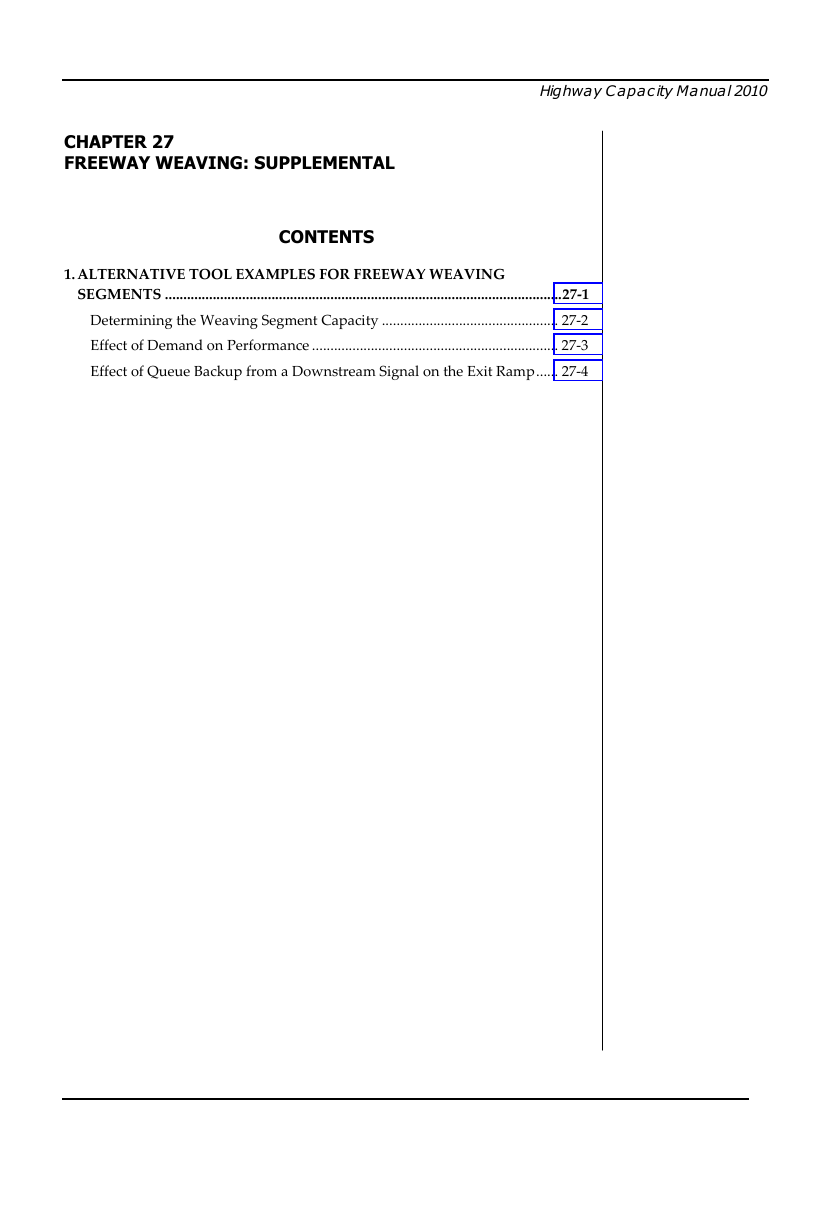
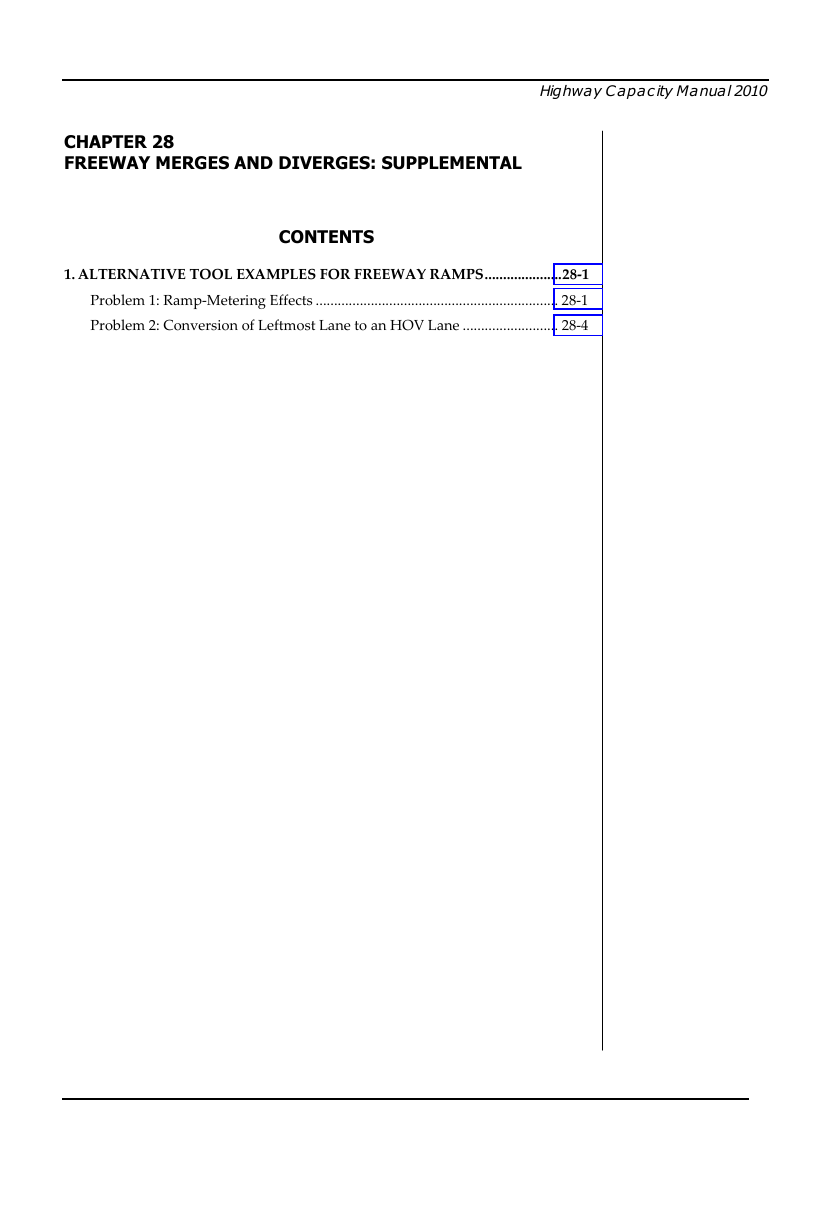
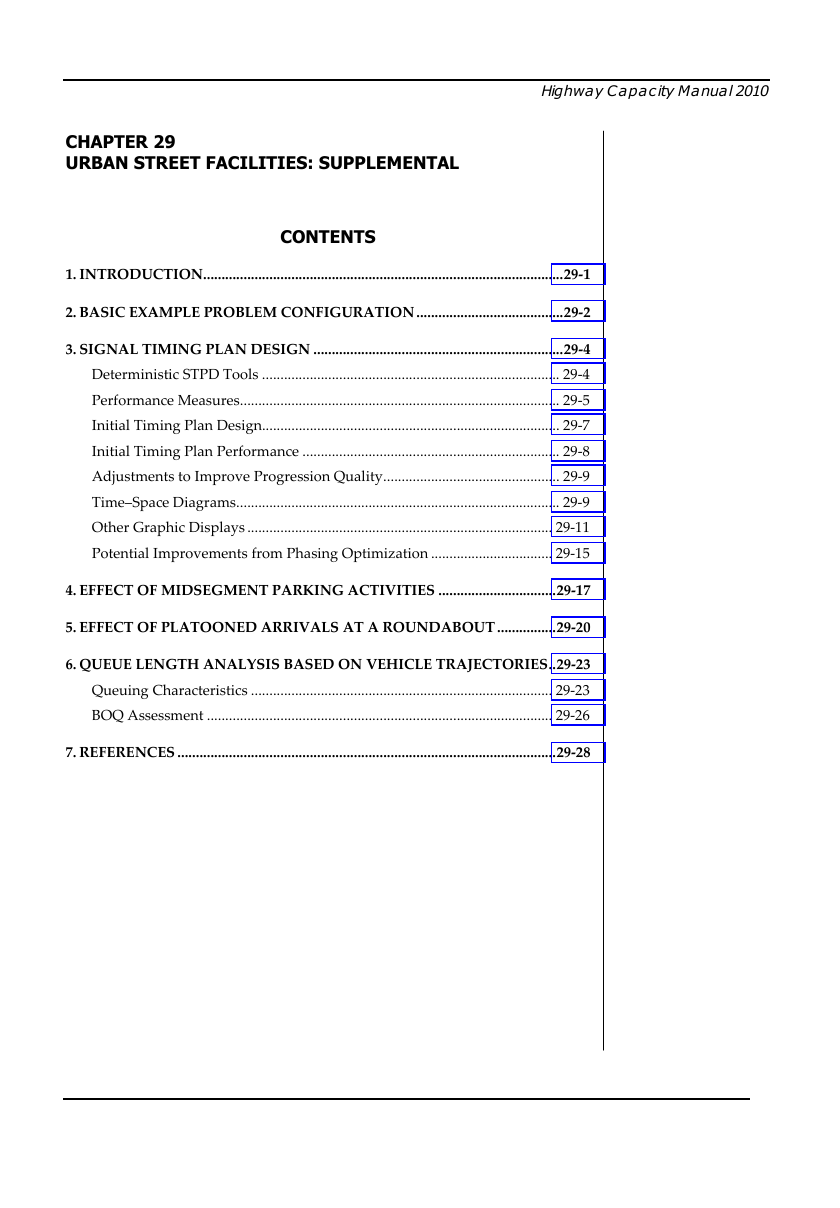
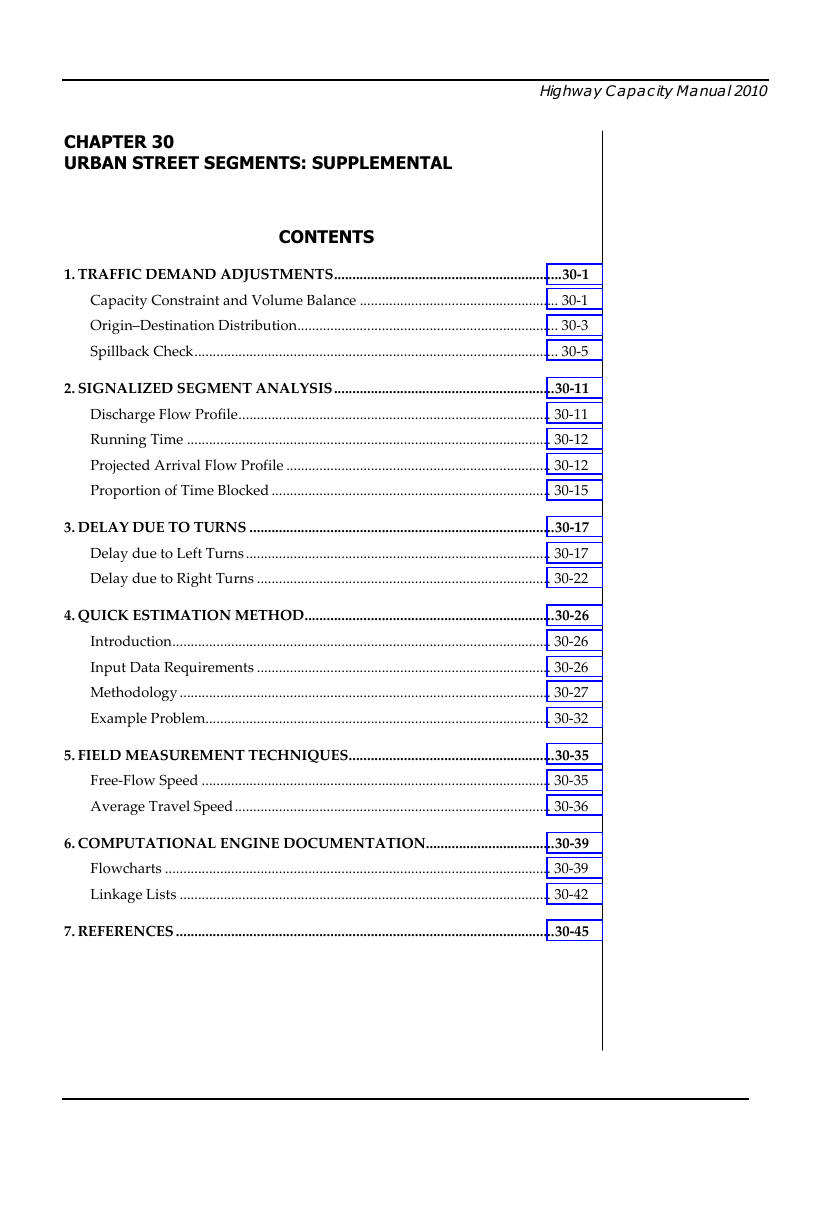

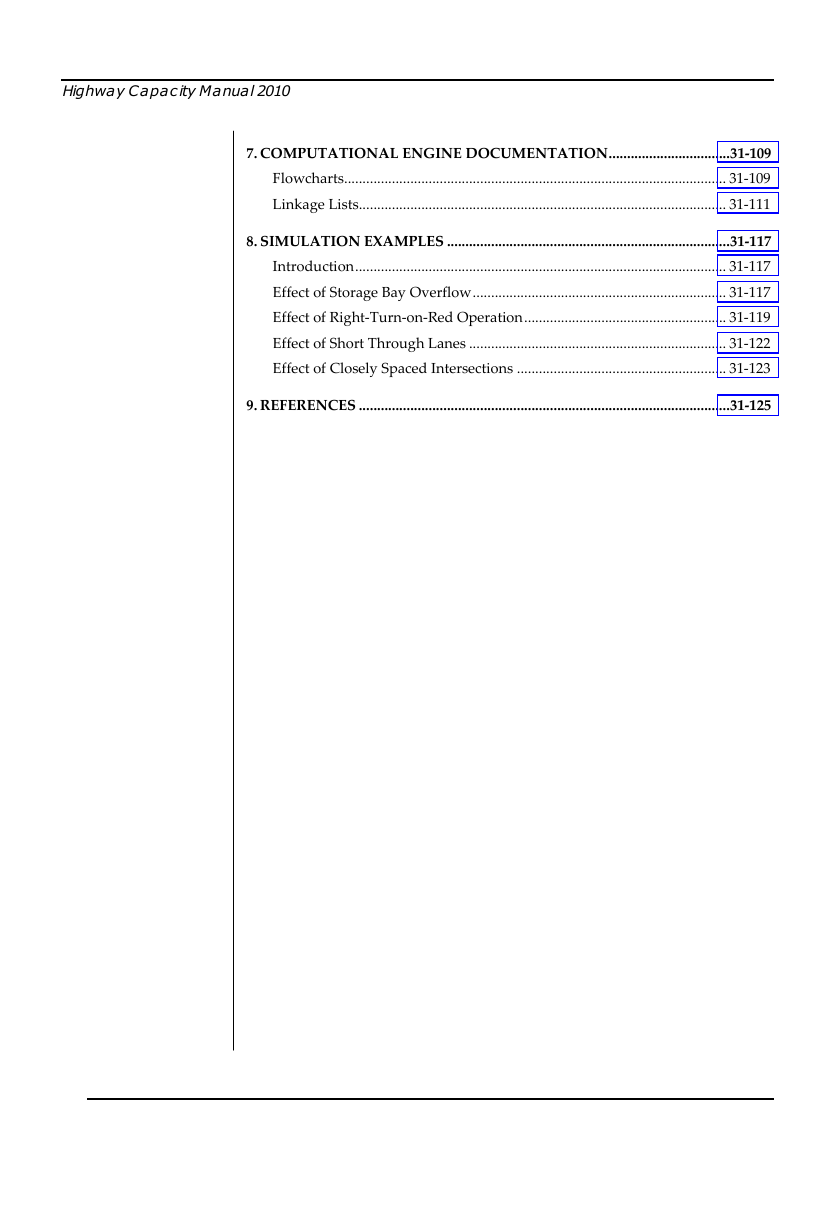








 2023年江西萍乡中考道德与法治真题及答案.doc
2023年江西萍乡中考道德与法治真题及答案.doc 2012年重庆南川中考生物真题及答案.doc
2012年重庆南川中考生物真题及答案.doc 2013年江西师范大学地理学综合及文艺理论基础考研真题.doc
2013年江西师范大学地理学综合及文艺理论基础考研真题.doc 2020年四川甘孜小升初语文真题及答案I卷.doc
2020年四川甘孜小升初语文真题及答案I卷.doc 2020年注册岩土工程师专业基础考试真题及答案.doc
2020年注册岩土工程师专业基础考试真题及答案.doc 2023-2024学年福建省厦门市九年级上学期数学月考试题及答案.doc
2023-2024学年福建省厦门市九年级上学期数学月考试题及答案.doc 2021-2022学年辽宁省沈阳市大东区九年级上学期语文期末试题及答案.doc
2021-2022学年辽宁省沈阳市大东区九年级上学期语文期末试题及答案.doc 2022-2023学年北京东城区初三第一学期物理期末试卷及答案.doc
2022-2023学年北京东城区初三第一学期物理期末试卷及答案.doc 2018上半年江西教师资格初中地理学科知识与教学能力真题及答案.doc
2018上半年江西教师资格初中地理学科知识与教学能力真题及答案.doc 2012年河北国家公务员申论考试真题及答案-省级.doc
2012年河北国家公务员申论考试真题及答案-省级.doc 2020-2021学年江苏省扬州市江都区邵樊片九年级上学期数学第一次质量检测试题及答案.doc
2020-2021学年江苏省扬州市江都区邵樊片九年级上学期数学第一次质量检测试题及答案.doc 2022下半年黑龙江教师资格证中学综合素质真题及答案.doc
2022下半年黑龙江教师资格证中学综合素质真题及答案.doc